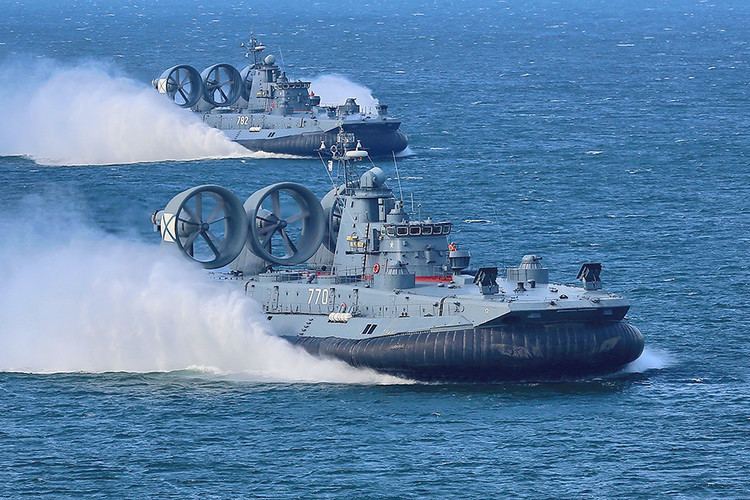In commission 1988-Present | Active 8 | |
 | ||
Builders PO More Feodosia Shipbuilding Company, Crimea Operators Russian NavyHellenic NavyPeople's Liberation Army Navy Type Air-cushioned landing craft Displacement 340 tons (light)415 tons (normal)555 tons (full load) | ||
The Zubr-class (Project 1232.2, NATO reporting name "Pomornik") is a class of air-cushioned landing craft (LCAC). This class of military hovercraft is, as of 2012, the world’s largest, with a standard full load displacement of 555 tons. The hovercraft is designed to sealift amphibious assault units (such as marines and tanks) from equipped/non-equipped vessels to non-equipped shores, as well as transport and plant naval mines.
Contents
There are currently seven Zubr-class hovercraft in active service worldwide with several pending delivery. There are two vessels in service with the Russian Navy and four with the Hellenic Navy. In 2009, China placed an order for four vessels from Ukraine as part of a deal worth 315 million USD. Two updated versions of the vessels will be built at Crimea's Feodosia Shipbuilding Company followed by two advanced models of the surface warship.
The purchase of HS Cephalonia (L 180) for the Hellenic Navy marked the first time a Soviet-designed naval craft had been built for a NATO member.
Configuration
High strength and buoyancy is provided by a rectangular pontoon, the main load-carrying part of the ship's hull. The superstructure built on the pontoon is divided into three compartments with two longitudinal bulkheads: combat material compartment in the midsection fitted with tank ramps, and outboard sections housing main and auxiliary propulsion units, troop compartments, living quarters, and NBC protection systems. To improve working conditions in the battle stations, troop compartments and living quarters are fitted with air-conditioning and heating-systems, sound/heat-insulating coatings, and structures made of vibration damping materials. The ship provides normal conditions for the crew to make meals and rest.
Personnel are protected against the effects of weapons of mass destruction by airtight sealing of combat stations, crew and troop compartments, augmented with individual gas masks and protection suits. The ship is also protected from magnetic influence mines with an active system to compensate for the magnetic fields generated by the ship and transported materials. The central command post and MS-227 device compartments are strengthened with alloy armor.
Capacity
The Zubr-class landing craft has a cargo area of 400 square metres (4,300 sq ft) and a fuel capacity of 56 tons. It can carry three main battle tanks (up to 150 tonnes), or ten armoured vehicles with 140 troops (up to 131 tonnes), or 8 armoured personnel carriers of total mass up to 115 tonnes, or 8 amphibious tanks or up to 500 troops (with 360 troops in the cargo compartment).
At full displacement the ship is capable of negotiating up to 5-degree gradients on non-equipped shores and 1.6m-high vertical walls. The Zubr remains seaworthy in conditions up to Sea State 4. The vessel has a cruising speed of 30-40 knots.
Operators
Russian Navy (2)
Hellenic Navy (2 + 2)
People's Liberation Army Navy (4: 2 delivered from Ukraine, 2 being built in China)
